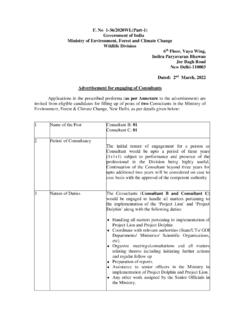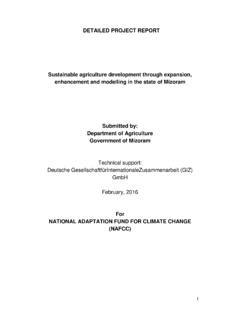Transcription of HANDBOOK ON CHEMICALS AND HAZARDOUS WASTE …
1 Hand Book on Chemical WasteNLSIUCENT RE FOR E NVIRONME NTAL LAW, EDUCAT ION,RESEARCH AND ADVOCACYNATIONAL LAW SCHOOL OF INDIA UNIVERSITYHANDBOOK ONCHEMICALS AND HAZARDOUS WASTEMANAGEMENT AND HANDLING IN INDIAMINISTRY OF environment , FOREST ANDCLIMATE CHANGE, GOVERNMENT OF INDIAJ ointly published by:Hand Book on Chemical WasteNLSIU National Law School of India University, By :CENTRE FOR ENVIRONMENTAL LAW, EDUCATION, RESEARCH ANDADVOCACYNATIONAL LAW SCHOOL OF INDIA UNIVERSITYP O Box 7201,Nagarbhavi, Bengaluru-560 0242 Printed by:Sri Vidya PrintersBengaluru Ph: 9986659590, 9035142247iiCopyright @ NLSIU, 2019 All rights reserved. No part of this book may be reproduced or utilised in any form of by any means electronicand mechanical, including photocopying, recording or by any information storage or otherwise, withoutpermission in writing from : 978-93-83363-79-7 Price : INR 500/-Hand Book on Chemical WasteNLSIUT able of ContentsPage of 1 CHEMICALS AND HAZARDOUS WASTE - OVERVIEW Chemical and Physical properties of Chemical properties of Chemical Harmonized System for Classification andLabelling of CHEMICALS (GHS).
2 11 CHAPTER 2 INTERVENTIONS OF INTERNATIONAL ORGANISATIONS IN THEFIELD OF CHEMICAL AND HAZARDOUS WASTE Working in the Field of CHEMICALS andHazardous WASTE Management at the International working in the field of CHEMICALS andHazardous WASTE Management at the Regional of HAZARDOUS WASTE adopted by International andRegional of HAZARDOUS WASTE within the Indian Legal Analysis of the Definitions of HAZARDOUS Wasteadopted by International and Regional Organizations andthe Indian Book on Chemical WasteNLSIUCHAPTER 3 INTERNATIONAL INSTRUMENTS ON CHEMICAL ANDHAZARDOUS WASTE MANAGEMENTAND for International Regulation in Chemical and HAZARDOUS factsheet of the Convention on the Transboundary Movement of HAZARDOUS Wastesand their Disposal (1989).. Convention on the Prior Informed Consent Procedure for CertainHazardous CHEMICALS and Pesticides in International Trade, Convention on Persistent Organic Pollutants (2001).
3 Approach toInternational CHEMICALS Management (SAICM) (2006).. Convention on Mercury (2017).. Response and Compliance to the of International Law on Management of HAZARDOUS Wastesand 4 OVERVIEW OF THE CHEMICAL SECTOR IN of the Chemical Sector as a contributor to Indian drivers for growth of the Chemical functioning of the Chemical faced in the Disposal, Storage andTransportation of HAZARDOUS Gas Tragedy- A Case of Inefficient WASTE Book on Chemical outlook on the need for effectiveChemical WASTE Need for Regulation of the Chemical Sector in Trade in CHEMICALS and the Indian 5 INDIAN REGULATIONS ON CHEMICAL AND HAZARDOUS Legal Framework on Chemical and HAZARDOUS WASTE in 6 LAW ON EMERGENCY, REMEDIAL AND PENAL ACTION IN RELATIONTO HAZARDS CAUSED BY CHEMICAL to Chemical Accidents and Disasters: An and HAZARDOUS Substance Accidents and Disasters:an overview of Environmental Accidents around the World.
4 Impact on the State of Accidents in India: Shortcomings of the Legal on the Legal Framework: Which Laws were applicable?.. and Challenges in Production, Storage and Transport ofChemicals in India:.. Manufacture, Storage and Import of HAZARDOUS Chemical Rules, (MSIHC)1989 & Chemical Accidents (Emergency Planning, Preparedness andResponse) Rules, (CAEPR) 1996; A Critical **vHand Book on Chemical WasteNLSIUviHand Book on Chemical WasteNLSIUThe HANDBOOK on CHEMICALS and HAZARDOUS WASTE Management and Handling in Indiais a result of the research undertaken by the Centre for Environmental Law, Education,Research and Advocacy (CEERA), National Law School of India University, expresses its gratitude to the Ministry of environment , Forest and ClimateChange (MoEF&CC), Government of India for granting the Three Year project on Collaborative Engagement for Research, Training and Development in Handling of Chemical andHazardous WASTE .
5 We express our sincere thanks to Mr. Manoj Kumar Gangeya,Director, MoEF & CC, and to Mr. Dinesh Runiwal, Scientist-D at MoEF & CC sOffice of HAZARDOUS Substances Management, for guiding us in this project and comingup with this would like to express earnest gratitude to our Vice Chancellor Prof. (Dr.) SudhirKrishnaswamy, for his encouragement in bringing forth our first publication under thisproject. We are thankful to Prof. (Dr.) Ramesh, our mentor and guide, for providinghis rich insights and for his relentless support to CEERA and the entire HANDBOOK has been a result of the contributions from Ms. Madhubanti Sadhyaand Mr. Rohith Kamath, who are the lead authors and other notable contributionsfrom Ms. Raagya P. Zadu, Mr. Raghav Parthasarathy, Mr. Vikas Gahlot andMs. Geethanjali , for putting in their efforts in bringing this (Dr.) Sairam BhatCoordinator, CEERAP rofessor of Law, NLSIUACKNOWLEDGMENTviiHand Book on Chemical WasteNLSIU viiiHand Book on Chemical WasteNLSIUIn the present times, the use of CHEMICALS is crucial for the growth of any economy,bearing in mind its application in almost all spheres of human activity.
6 It is the mainstayof several sections of the economy and contributes largely for the growth of the industrialand agricultural sector by providing raw materials to a number of industries, includingtextile, paper, paint, soap and detergent, pharmaceutical, bulk drugs and formulations,agrochemicals. It also has extensive domestic application. Besides use of importedchemicals in different industries, the chemical sector is an industry in its own rightproducing a wide array of products such as inorganic CHEMICALS , synthetic organicchemicals like drugs and pharmaceuticals, dyes and intermediates, pigments, fine andspecialty CHEMICALS , chlor-alkali, pesticides, colorants and alcohol based CHEMICALS . Indiaranks sixth in the world in the production of CHEMICALS and fourth in the production ofagro- CHEMICALS . India accounts for 16 per cent of the dye stuff and dye intermediariesand is a global supplier of dyes.
7 Excluding pharmaceutical products, the chemical industryin India ranks 14th in global exports, employs more than 2 million people and its value isexpected to rise to 304 billion dollars by the use and importance of the chemical sector as one of the drivers of the economycannot be denied, the harmful effects that some chemical substances and the hazardouswaste generated through their use pose must not be disregarded. Chemical substancesand HAZARDOUS WASTE by their very nature and physical characteristics often lead tosignificant hazards. Directly or indirectly, they pose major threats to human health andthe environment if not managed or utilised cautiously. The HAZARDOUS nature of chemicalsubstances and WASTE and the sheer magnitude of the Indian chemical industry, the widespectrum of products manufactured and the impact that the industry has on the safetyand livelihood of the persons engaged with the sector, makes it incumbent on the stateto devise a regulatory mechanism for the chemical industry.
8 In keeping with therequirements of the industry and the challenges it can pose, especially in terms ofenvironmental and health risk, the country has devised a comprehensive legislativeframework for the management of Book on Chemical WasteNLSIUThe HANDBOOK on CHEMICALS and HAZARDOUS WASTE Management and Handling in Indiaendeavours to give a broad overview of the legislative and regulatory framework governingthe chemical sector in India. Designed to serve as a ready reckoner for stakeholdersworking in the field of CHEMICALS and HAZARDOUS WASTE , such as members and officers ofthe Pollution Control Boards, allied institutions of the Ministry of environment , Forestand Climate Change, other regulatory authorities, officials and employees of hazardouswaste management companies and chemical industries, importers and exporters ofchemicals and WASTE , the HANDBOOK outlines the core objectives of the different Acts,Rules and Regulations that regulate different aspects of CHEMICALS and HAZARDOUS of the legislative framework in India that governs CHEMICALS and HAZARDOUS wasteowes its origin to different Multilateral Environmental Agreements on HAZARDOUS WASTE ,to which India is a signatory.
9 The HANDBOOK also delineates the core principles of fivemajor Conventions on HAZARDOUS WASTE and the obligations that the country has to fulfilin furtherance of their objectives. Spread across six chapters, the HANDBOOK presents toits readers a holistic picture of the chemical sector in India and attempts to apprise themabout the fundamental concepts that influence and govern chemical and HAZARDOUS wastemanagement and handling in the the properties of chemical substances and HAZARDOUS wasteis pertinent,since it enables persons dealing with these substances to identify their nature and gaugehow the substances could react under different conditions. The First Chapter, Chemicalsand HAZARDOUS WASTE : Overview and Definition gives an overview of CHEMICALS andhazardous wastes and delineates the physical, chemical and HAZARDOUS properties ofchemical substances and HAZARDOUS WASTE that aids in their identification.
10 The chapteralso discusses the Globally Harmonized System for Classification and Labelling ofChemicals, the internationally harmonized system of organizing and labelling chemicalsand the criteria adopted by GHS for classifying chemical substances and mixturesaccording to their health, environmental and physical Second Chapter, sheds light on the interventions of the international and regionalorganisations in the field of chemical and HAZARDOUS WASTE management. Initiatives takenxHand Book on Chemical WasteNLSIUup by international organizations to the likes of United Nations environment Programme(UNEP), Organisation for Economic Cooperation and Development (OECD), GlobalEnvironment Facility (GEF), International Maritime Organisation, Inter-OrganisationProgramme for the Sound Management of CHEMICALS and regional organizations like theEuropean Union, the African Union, and the North American Agreement onEnvironmental Cooperation are delineated.







